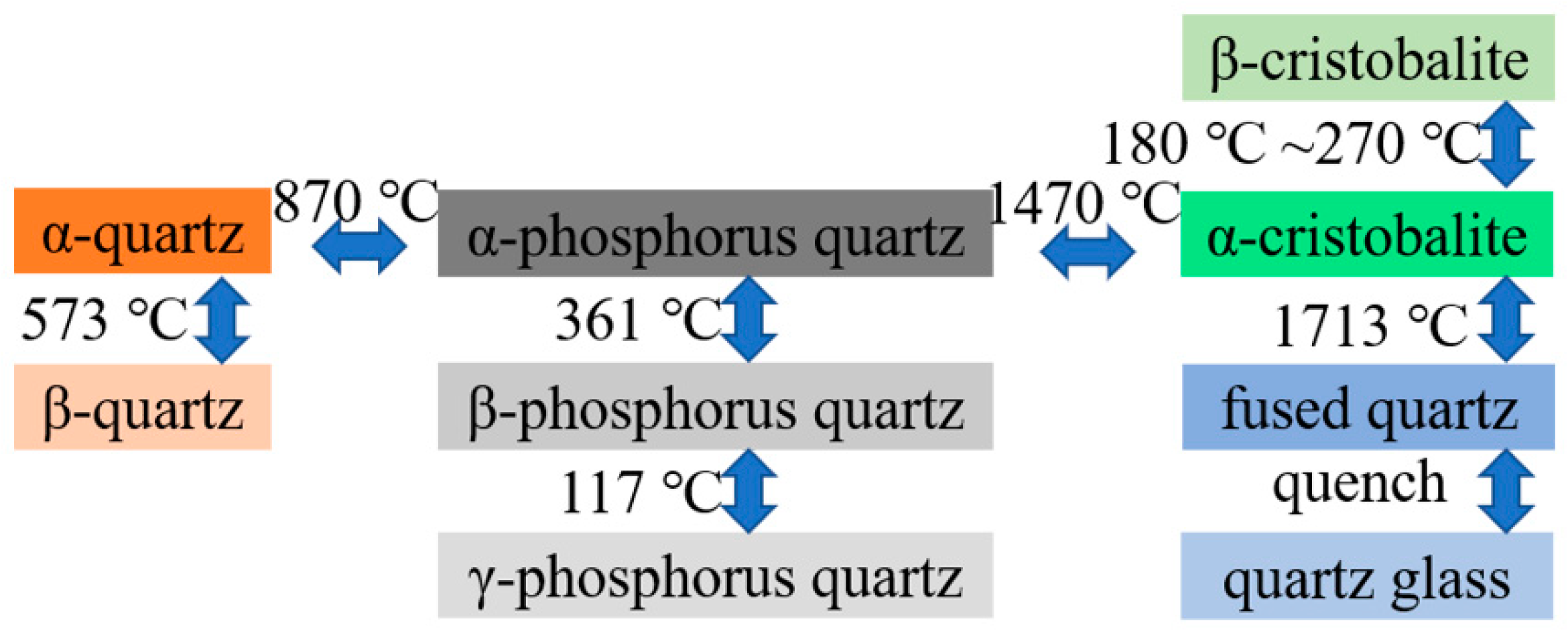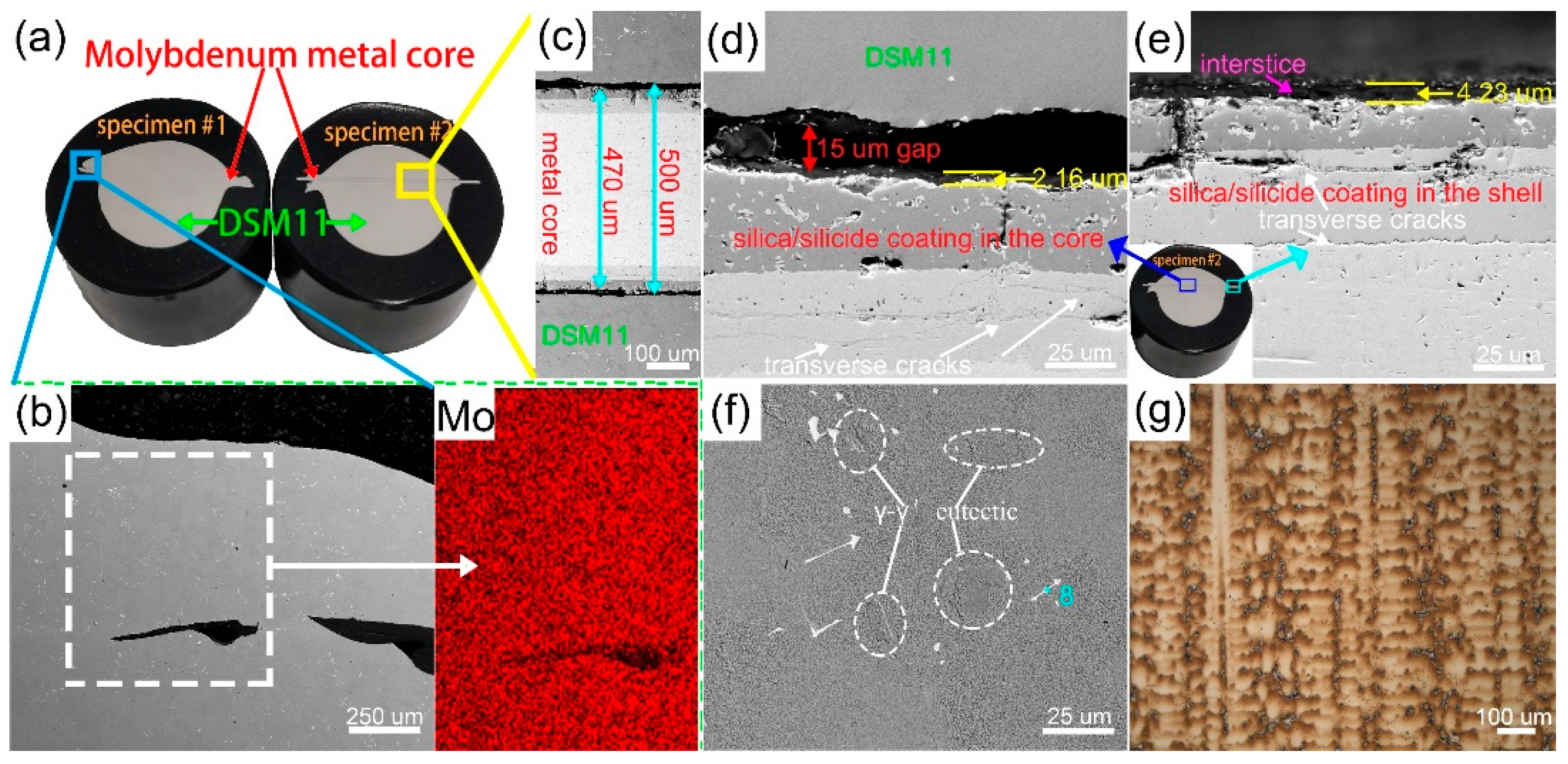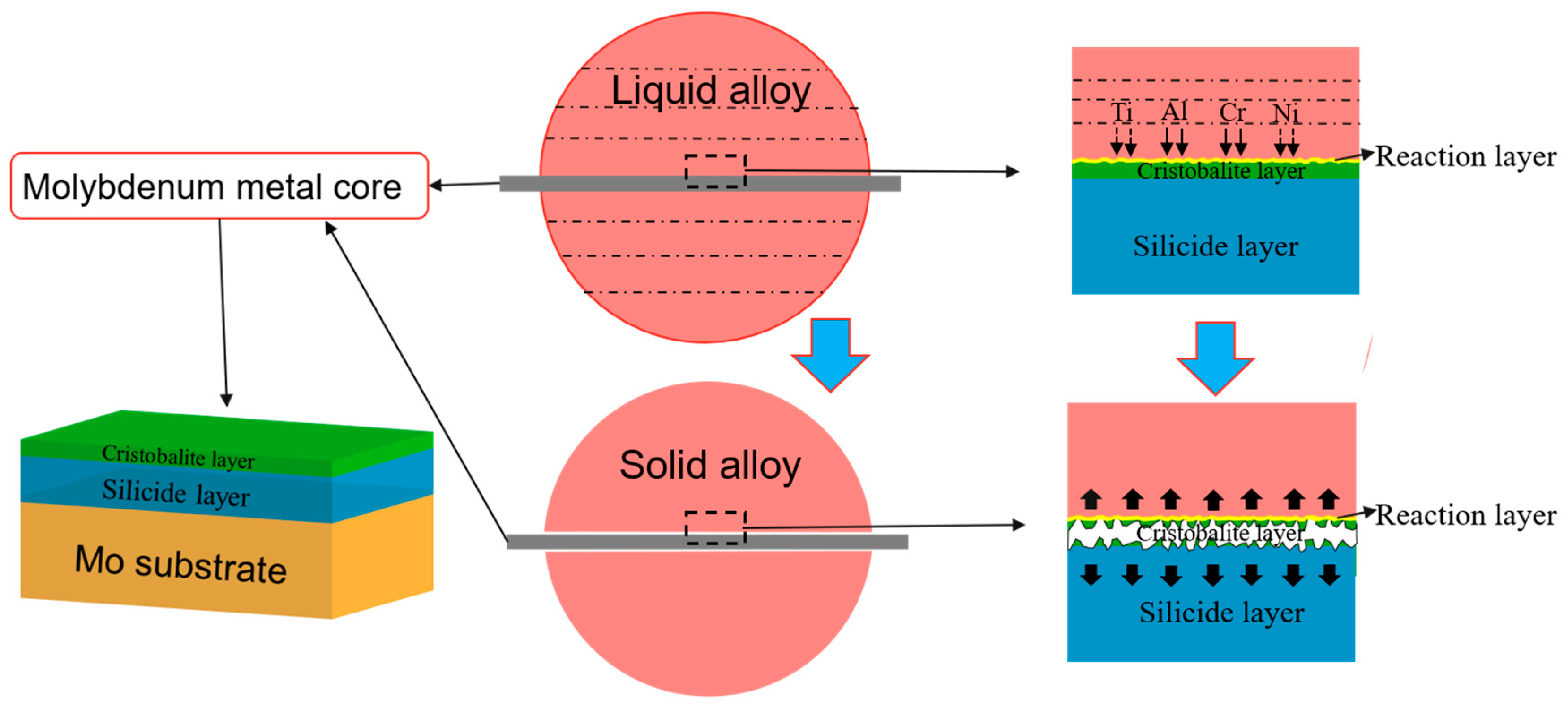Resistance to Molten Superalloy at 1550 °C for Molybdenum Metal Core with a Silica/Silicide Coating
Abstract
:1. Introduction
2. Experiment Procedures
2.1. Prepared Coating
2.2. Casting Test
2.3. Characterizations
3. Results and Discussion
3.1. The Microstructure Evolution of As-Coated Specimens after Oxidation
3.2. The Microstructure of As-Coated Specimens after Casting Test
3.3. Interfacial Microstructure between Superalloy and Core
4. Conclusions
- The service life and oxidized coating structure rely on the MoSi2 thickness. After oxidation, the 40-µm MoSi2 structure is composed of SiO2, MoSi2, and Mo5Si3 at 1300 °C for 10 h. Meanwhile, the silica formed on the surface is cristobalite at 1300 °C for above 2 h.
- The silicide coating and Mo metal are dissolved in the alloy, whereas the cristobalite layer prevents the alloy from entering the substrate. By contrast, the primary function of intermetallic compound coating can offer the oxidation-resistant abilities and the cristobalite layer plays an important role in resisting the corrosion of superalloy.
- Although the cristobalite layer protects the molybdenum metal core, this layer was destroyed during the casting test. Furthermore, the Si-rich phase is not formed in the DSM11 alloy and growth orientation is not affected by the molybdenum core. In addition, the formation of a 15-µm gap could be attributed to the cooling shrinkage and surface wettability.
- The failure mechanism of the destroyed cristobalite layer is proposed during the cast process. The corrosion-resistant process of the cristobalite layer is presented in two stages: the formation of reaction layer, and the solidification shrinkage. The active elements react with cristobalite to form a reaction layer. Furthermore, the overly high temperature prompts the reactions. The reaction layer is bonded to the alloy surface. In the solidification stage, the volume shrinkage of the DSM11 and cores gives rise to the tensile forces. The cristobalite layer is torn by the tension.
Author Contributions
Funding
Institutional Review Board Statement
Informed Consent Statement
Data Availability Statement
Acknowledgments
Conflicts of Interest
References
- Beals, J.T.; Shah, D.M.; Snyder, J.; Wiedemer, J. Refractory Metal Core. U.S. Patent 6,91,3064, 5 July 2005. [Google Scholar]
- Smolik, G.R.; Petti, D.A.; Schuetz, S.T. Oxidation and volatilization of TZM alloy in air. J. Nucl. Mater. 2000, 283–287, 1458–1462. [Google Scholar] [CrossRef] [Green Version]
- Beals, J.T.; Persky, J.; Shah, D.M.; Seetharaman, V.; Bose, S.; Snyder, J.; Santeler, K.; Verner, C.; Murray, S.D.; Marcin, J.; et al. Refractory Metal Core Coatings. U.S. Patent 7,575,039, 8 August 2009. [Google Scholar]
- Bae, C.-J.; Kim, D.; Halloran, J.W. Mechanical and kinetic studies on the refractory fused silica of integrally cored ceramic mold fabricated by additive manufacturing. J. Eur. Ceram. Soc. 2019, 39, 618–623. [Google Scholar] [CrossRef]
- Schmidt, W.R.; Jaworowski, M.R.; Beals, J.T.; Nardone, V.C.; United Technologies Corp. Method for Casting Core Removal. U.S. Patent 7,882,884, 10 July 2011. [Google Scholar]
- Wereszczak, A.A.; Breder, K.; Ferber, M.K.; Kirkland, T.P.; Payzant, E.A.; Rawn, C.J.; Krug, E.; Larocco, C.L.; Pietras, R.A.; Krug, E.; et al. Dimensional changes and creep of silica core ceramics used in investment casting of superalloys. J. Mater. Sci. 2002, 37, 4235–4245. [Google Scholar] [CrossRef]
- Xu, Z.; Zhong, J.; Su, X.; Xu, Q.; Liu, B. Experimental study on mechanical properties of silica-based ceramic core for directional solidification of single crystal superalloy. Ceram. Int. 2018, 44, 394–401. [Google Scholar] [CrossRef]
- Kanyo, J.E.; Schafföner, S.; Uwanyuze, R.S.; Leary, K.S. An overview of ceramic molds for investment casting of nickel superalloys. J. Eur. Ceram. Soc. 2020, 40, 4955–4973. [Google Scholar] [CrossRef]
- Kazemi, A.; Faghihi-Sani, M.A.; Alizadeh, H.R. Investigation on cristobalite crystallization in silica-based ceramic cores for investment casting. J. Eur. Ceram. Soc. 2013, 33, 3397–3402. [Google Scholar] [CrossRef]
- Zhang, P.; Guo, X.; Zhang, C.; Tao, Q.; Shen, C. Deposition and oxidation behavior of Mo(Si,Al)2/MoB layered coatings on TZM alloy. Int. J. Refract. Met. Hard Mater. 2017, 67, 32–39. [Google Scholar] [CrossRef]
- Sakidja, R.; Rioult, F.; Werner, J.; Perepezko, J.H. Aluminum pack cementation of Mo–Si–B alloys. Scr. Mater. 2006, 55, 903–906. [Google Scholar] [CrossRef]
- Yoon, J.-K.; Kim, G.-H.; Byun, J.-Y.; Lee, J.-K.; Paik, Y.-H.; Kim, J.-S. Formation of MoSi2–Si3N4 composite coating by reactive diffusion of Si on Mo substrate pretreated by ammonia nitridation. Scr. Mater. 2002, 47, 249–253. [Google Scholar] [CrossRef]
- Alam, M.Z.; Venkataraman, B.; Sarma, B.; Das, D.K. MoSi2 coating on Mo substrate for short-term oxidation protection in air. J. Alloys Compd. 2009, 487, 335–340. [Google Scholar] [CrossRef]
- Suzuki, R.O.; Ishikawa, M.; Ono, K. MoSi2 coating on molybdenum using molten salt. J. Alloys Compd. 2000, 306, 285–291. [Google Scholar] [CrossRef]
- Sun, J.; Fu, Q.-G.; Guo, L.-P.; Liu, Y.; Huo, C.-X.; Li, H.-J. Effect of filler on the oxidation protective ability of MoSi2 coating for Mo substrate by halide activated pack cementation. Mater. Des. 2016, 92, 602–609. [Google Scholar] [CrossRef]
- Pang, J.; Wang, W.; Zhou, C. Microstructure evolution and oxidation behavior of B modified MoSi2 coating on Nb–Si based alloys. Corros. Sci. 2016, 105, 1–7. [Google Scholar] [CrossRef]
- Yoon, J.-K.; Lee, J.-K.; Lee, K.-H.; Byun, J.-Y.; Kim, G.-H.; Hong, K.-T. Microstructure and growth kinetics of the Mo5Si3 and Mo3Si layers in MoSi2/Mo diffusion couple. Intermetallics 2003, 11, 687–696. [Google Scholar] [CrossRef]
- Li, W.; Fan, J.; Fan, Y.; Xiao, L.; Cheng, H. MoSi2/(Mo,Ti)Si2 dual-phase composite coating for oxidation protection of molybdenum alloy. J. Alloys Compd. 2018, 740, 711–718. [Google Scholar] [CrossRef]
- Chakraborty, S.P.; Banerjee, S.; Sharma, I.G.; Suri, A.K. Development of silicide coating over molybdenum based refractory alloy and its characterization. J. Nucl. Mater. 2010, 403, 152–159. [Google Scholar] [CrossRef]
- Lohfeld, S.; Schütze, M.; Böhm, A.; Güther, V.; Rix, R.; Scholl, R. Oxidation behaviour of particle reinforced MoSi2 composites at temperatures up to 1700 °C. Mater. Corros. 2005, 56, 250–258. [Google Scholar] [CrossRef] [Green Version]
- Wang, H.; Yang, J.; Meng, J.; Yang, Y.; Zhou, Y. Wettability and interfacial reactions of a low Hf-containing nickel-based superalloy on Al2O3-based, SiO2-based, ZrSiO4, and CoAl2O4 substrates. Ceram. Int. 2020, 46, 22057–22066. [Google Scholar] [CrossRef]
- Chu, F.; Thoma, D.J.; McClellan, K.; Peralta, P.; Hey, Y. Synthesis and properties of Mo5Si3 single crystals. Intermetallics 1999, 7, 611–620. [Google Scholar] [CrossRef]
- Yang, C.; Xu, Y.; Zhang, Z.; Nie, H.; Xiao, X.; Jia, G.; Shen, Z. Improvement of stress-rupture life of GTD-111 by second solution heat treatment. Mater. Des. 2013, 45, 308–315. [Google Scholar] [CrossRef]
- Dadkhah, A.; Kermanpur, A. On the precipitation hardening of the directionally solidified GTD-111 Ni-base superalloy: Microstructures and mechanical properties. Mater. Sci. Eng. A 2017, 685, 79–86. [Google Scholar] [CrossRef]
- Kazemi, A.; Faghihi-Sani, M.A.; Nayyeri, M.J.; Mohammadi, M.; Hajfathalian, M. Effect of zircon content on chemical and mechanical behavior of silica-based ceramic cores. Ceram. Int. 2014, 40, 1093–1098. [Google Scholar] [CrossRef]
- Ringdalen, E. Changes in Quartz During Heating and the Possible Effects on Si Production. JOM 2014, 67, 484–492. [Google Scholar] [CrossRef] [Green Version]
- Zheng, L.; Xiao, C.; Zhang, G.; Gu, G.; Li, X.; Liu, X.; Xue, M.; Tang, D. Investigation of interfacial reaction between high Cr content cast nickel based superalloy K4648 and ceramic cores. J. Aeronaut. Mater. 2012, 32, 10–22. [Google Scholar]
- Li, Q.; Song, J.; Wang, D.; Yu, Q.; Xiao, C. Effect of Cr, Hf and temperature on interface reaction between nickel melt and silicon oxide core. Rare Met. 2011, 30, 405–409. [Google Scholar] [CrossRef]
- Zhang, P.; Guo, X.; Ren, X.; Chen, Z.; Shen, C. Development of Mo(Si,Al)2-MoB composite coatings to protect TZM alloy against oxidation at 1400 °C. Intermetallics 2018, 93, 134–140. [Google Scholar] [CrossRef]
- Majumdar, S.; Sharma, I.G. Oxidation behavior of MoSi2 and Mo(Si,Al)2 coated Mo–0.5Ti–0.1Zr–0.02C alloy. Intermetallics 2011, 19, 541–545. [Google Scholar] [CrossRef]






| Element | C | Cr | Ni | Co | W | Mo | Al | Ti | Ta | B |
|---|---|---|---|---|---|---|---|---|---|---|
| Wt% | 0.07~0.12 | 13.50~14.30 | bal. | 9.00~10.00 | 3.50~4.10 | 1.30~1.70 | 2.80~3.40 | 4.60~5.20 | 2.50~3.10 | 0.007~0.02 |
| Spot-Position | Element Component | Spot-Position | Element Component |
|---|---|---|---|
| 1–Figure 1c | 48.04Si–51.96O | 6–Figure 3b | 14.38Si–10.74Mo–74.88O |
| 2–Figure 1c | 36.88Si–63.12Mo | 7–Figure 3b | 40.07Si–59.93O |
| 3–Figure 1c | 65.84Si–34.16Mo | 8–Figure 4f | 45.75C–30.84Ti–1.3Cr–2.02Ni–15.73Ta–4.37W |
| 4–Figure 1c | 45.73Si–54.27Mo | 9–Figure 5a | 23.01Si–27.13Mo–49.86O |
| 5–Figure 3a | 26.01Si–6.07Mo–67.92O | 10–Figure 5b | 4.82Al–28.26Si–22.44Cr–44.48O |
Publisher’s Note: MDPI stays neutral with regard to jurisdictional claims in published maps and institutional affiliations. |
© 2021 by the authors. Licensee MDPI, Basel, Switzerland. This article is an open access article distributed under the terms and conditions of the Creative Commons Attribution (CC BY) license (http://creativecommons.org/licenses/by/4.0/).
Share and Cite
Zhang, C.; Liu, E.; Zheng, Z.; Ning, L.; Tong, J.; Tan, Z.; Li, H. Resistance to Molten Superalloy at 1550 °C for Molybdenum Metal Core with a Silica/Silicide Coating. Coatings 2021, 11, 275. https://doi.org/10.3390/coatings11030275
Zhang C, Liu E, Zheng Z, Ning L, Tong J, Tan Z, Li H. Resistance to Molten Superalloy at 1550 °C for Molybdenum Metal Core with a Silica/Silicide Coating. Coatings. 2021; 11(3):275. https://doi.org/10.3390/coatings11030275
Chicago/Turabian StyleZhang, Chong, Enze Liu, Zhi Zheng, Likui Ning, Jian Tong, Zheng Tan, and Haiying Li. 2021. "Resistance to Molten Superalloy at 1550 °C for Molybdenum Metal Core with a Silica/Silicide Coating" Coatings 11, no. 3: 275. https://doi.org/10.3390/coatings11030275






